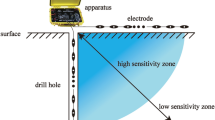Abstract
Underground pipelines are the lifelines of a modern city. The precise positioning of underground pipelines is essential to avoid pipeline damage during successive construction above it. However, detecting deep-buried pipelines in soft clayey deposits is challenging. This paper proposes a new method called the surface-to-borehole electromagnetic induction method (SB–EIM) by combining the traditional ground EIM with the magnetic gradient response in a borehole. Firstly, a depth measurement method was established based on the magnetic fl ux response to the applied magnetic field in a borehole. Secondly, a theoretical analysis method was proposed to calculate the pipeline depth and its horizontal position using the measured data. By analyzing the magnetic flux response characteristics at different depths, the relationship between the maximum response point and the spatial location of the target pipeline was determined. Finally, an in-situ test was conducted, and the eff ectiveness of the proposed method was verified.
Similar content being viewed by others
References
Chen, J. Chen, Z. Y., Yang, C., 2015, Borehole Magnetic Gradient Method Based on Detection of Deep Underground Pipeline: Earth Science (in Chinese), 40(12): 2110–2118.
CHEN, L. X., SU, Z., LU, J. G, et al., 2016, Application of Urban Underground Pipeline Detection Technology Under Complex Conditions: World Nonferrous Metals, 2016 (22),19–20.
CHEN, S. J., HU, X. Y., PENG, R. H., 2021, Review of urban underground pipeline detection: Progress in Geophysics (in Chinese), 36(3), 1236–1247.
CHENG, J. Z., CHEN, Q. H., BIAN, J. Z., et al., 2021, Application of ground penetrating radar to substation concealed pipeline detection: Modern Radar (in Chinese), 43(2), 82–88.
DYCK, A., and WEST, G., 1984, The role of simple computer models in interpretation of wide-band, drillhole electromagnetic surveys in mineral exploration: Geophysics, 49(7), 957–980.
DING, Z. Q., and QI, B. L., 2012, Construction Method of 110 kV Power Cable Crossing the 380 m Wide River: East China Electric Power (in Chinese), 40(04), 604–607.
GUO, T., LI, J. X, LIU, Y., et al., 2019, Research on Detection of Underground Pipeline Based on Chaotic Pulse Position Modulation Signal: Chinese Journal of Electron Devices (in Chinese), 42(05), 1278–1283.
HAN, S. S., WANG, Z. T., GUO, K., 2016, Survey of Underground Pipeline Detection Methods: Bulletin of surveying and mapping (in Chinese), 0629, 104–106+109.
HAN, J. M., ZHONG, X., JING, S., et al., 2020, The application of geological radar to urban geological pipeline detection in the loess area: Geophysical and Geochemical Exploration (in Chinese). 44(6), 1496–1481.
HUANG, P. F., 2021, Study on fine detection methods of non-excavation pipelines: Bulletin of surveying and mapping (in Chinese), 2021(05), 40–144.
HU, Y. Y., YE, R. H., CHEN, C. Q., 2021, The detection technology and application research of deep buried pipeline in ningbo city: Bulletin of surveying and mapping (in Chinese), 2021(S2), 156–161.
LIU, X. D., ZHANG, H. S., ZHU, W. Z., 2001, Application of High Density Electrical Method in Engineering Geophysical Prospecting: Geotechnical Investigation and surveying (in Chinese), 2001(04),64–66.
LIU, X. T., TANG, H. M., ZHAO, D. F, 2009, Construction technology of trenchless laying pipes: Construction Technology (in Chinese), 38(S2), 458–461.
LU, M., 2019, Application of borehole magnetic method in deep buried pipeline detection: Soil Eng. And Foundation, 33(06), 717–719+725.
MACNAE, J., and STALTARI, G., 1987, Classification of sign changes in borehole TEM decays: Exploration Geophysics, 18(3), 331–339.
MENG, Q. X., and PAN, H. P., 2012, Numerical simulation analysis of surface-hole TEM responses: Chinese Journal of Geophysics (in Chinese), 55(3), 1046–1053.
Wang, F. G., and YE, G. H., 2001, Application of frequency domain electromagnetic method in detecting underground pipelines. Chinese Journal of Rock Mechanics and Engineering (in Chinese), 2001(S1), 1787–1789.
WANG, J., JIANG, Y. F., ZHU, N. F., et al., 2015, Application of Integrated Pipeline Detection Technology in the Urban Pipeline Detection: Bulletin of surveying and mapping (in Chinese), 0683, 52–56.
XU, H. F., LU, F., DAI, W. S., 2010, Main Points and Experience of Trenchless Construction Technology of Large-diameter PE Pipe: China Water and Wastewater (in Chinese). 26(08), 108–112.
XU, X. L., ZHAO, Y. L., WANG, F., et al., 2012, Review on diameter detection of underground pipe with GPR: Progress in Geophysics, 27(5), 2206–2215.
ZHOU, H. L., and YU, J. L., 2014, The Classification of Urban Underground Pipelines and Research of Geophysical Detecting Method: Chinese Journal of Engineering Geophysics, 11(01), 133–136.
Acknowledgment
This research is supported by the National Natural Science Foundation of China (No. 42177126).
Author information
Authors and Affiliations
Corresponding author
Additional information
Li Guo-wei is a Professor and doctoral student supervisor at Hohai University, mainly engaged in the research of soft foundation treatment, application of GFRP bars in geotechnical engineering, slope stability and the development of intelligent monitoring systems and instruments.
Zhou Yang is an Associate Professor and doctoral student supervisor; his main research direction is the improvement of soft ground, treatment of dredged slurry and application of geophysical methods in geotechnical engineering.
Rights and permissions
About this article
Cite this article
Li, GW., Ye, ZM., Zhou, Y. et al. Pipeline positioning by the surface-to-borehole electromagnetic induction method in a clayey deposit. Appl. Geophys. 20, 88–99 (2023). https://doi.org/10.1007/s11770-023-1019-x
Received:
Revised:
Published:
Issue Date:
DOI: https://doi.org/10.1007/s11770-023-1019-x




